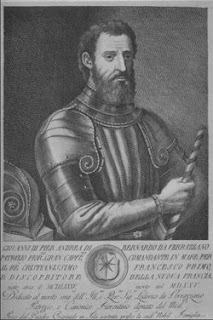1524: Giovanni de Verazzano
 Giovanni de Verazzano was born sometime in 1485, at Val di Greve, near Florence, in present day Italy. He entered the naval service of le Roi FrancoisI of France, he soon became famous as a corsair, preying on the ships of Spain and Portugal, one of his prizes in 1522 being the treasure-ship sent to Rey Carlos V of Spain by Cortés with Mexican spoils.
Giovanni de Verazzano was born sometime in 1485, at Val di Greve, near Florence, in present day Italy. He entered the naval service of le Roi FrancoisI of France, he soon became famous as a corsair, preying on the ships of Spain and Portugal, one of his prizes in 1522 being the treasure-ship sent to Rey Carlos V of Spain by Cortés with Mexican spoils.In Jan., 1524, he began a voyage of discovery aboard the ship Dauphine in the company of the Normandie to the New World on the behalf of his patron King Francis I, during which he kept a log-book of his experiences. In 1556 Ramusio published in his collection of voyages a letter written by Verrazano giving an account of his voyage to the coast of North America.
…We set sail with the Dauphine from the deserted rock near the Island of Madeira, which belongs to the Most Serene King of Portugal on the 17th day of January last; we had fifty men, and were provided with food for eight months, with arms and other articles of war, and naval munitions; we sailed westward on the gentle breath of a light easterly wind. In 25 days we covered eight hundred leagues…

The greater part of the present east coast of the United States, including North Carolina, was first described by Verrazzano. The point where Verrazzano first sighted land has never been established conclusively but is understood by many to have been at the mouth of the Cape Fear, a few minutes south of the 34th parallel.
…We departed this place (Cape Fear vicinity), still running along the coast, which we found to trend toward the east, and we saw everywhere very great fires, by reason of the multitude of the inhabitants. While we rode on that coast, partly because it had no harbor, and for that we wanted water, we sent our boat ashore with twenty-five men...
...Heavy seas kept the boat from landing, but one man swam ashore, where he was met by a group of Indians and “cried out piteously.” Initially fearful for his life, he was welcomed around “a great fire” and, after a while, allowed to return to the ship...
His is the first post-Columbian description of the North Atlantic coast, and gives the first description of New York Bay and harbour and the present Hudson River. Thence he sailed along Long Island Sound to Block Island and Newport, of which he makes mention. From this note-book of the voyage his brother Hieronimo(1) drew in 1529 a map of the North Atlantic coast, which is now in the Museo Di Roma, and testifies to the accuracy of Verrazano's observations along the coast as far as a point in the present State of Maine, whence he returned to France, arriving at Dieppe in July, 1524.
Little that is authentic is known of his subsequent career(2); Spanish records relate that he was captured in 1527, while cruising off the coast of Cadiz, and executed by order of the Emperor Carlos V. Other reports claim he was eaten by cannibals in the Antilles. However he died, the authenticity of his letter, describing his voyage along the Atlantic coast has given rise to an extensive historical controversy, but the most recent researches affirm its reliability as well as that of his brother's map, the best sixteenth-century map extant in its original form, which has special influence on the subsequent cartography of the time.
(1) Hieronimo, (fr. latin Hieronimous, Jerome)
(2) Virtually unknown, Verrazzano has been raised from obscurity through the efforts of John N. LaCorte, founder of the Italian Historical Society of America.
Letter to Francois I, found here...http://bc.barnard.columbia.edu/~lgordis/earlyAC/documents/verrazan.htm
Brantigny
